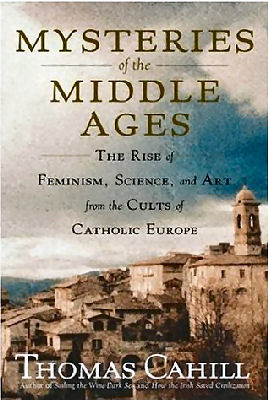
|
Posted March 27, 2007
Book: Mysteries of the Middle Ages: The Rise of Feminism, Science, and Art from the Cults of Catholic Europe Author: Thomas Cahill Double Day. New York. 2006. Pp. 343 An Excerpt from the Jacket:
By placing the image of the Virgin Mary at the center of their churches and their lives, medieval people exalted womanhood to a level unknown in any previous society. For the first time, men began to treat women with dignity, and women took up professions that had always been closed to them. The communion bread, believed to be the body of Jesus, encouraged the formulation of new questions in philosophy: could reality be so fluid that one substance could be transformed into another? Could ordinary bread become a holy reality? Could mud become gold, as the alchemists believed? These new questions pushed the minds of medieval thinkers toward what would become modern science. Artists began to ask themselves similar questions: How can we depict human anatomy so that it looks real to the viewer? How can we depict motion in a composition that never moves? How can two dimensions appear to be three? Medieval artists (and writers, too) invented the Western tradition of realism. On visits to the great cities of Europe – monumental Rome, the intellectually explosive Paris of Peter Abelard and Thomas Aquinas, the hotbed of scientific study that was Oxford, and the incomparable Florence of Dante and Giotto — Cahill brilliantly captures the spirit of experimentation, the colorful pageantry, and the passionate pursuit of knowledge that built the foundations for the modern world. An Excerpt from the Book: In reading the works of Roger Bacon, one cannot go far without running into his Platonian assumptions — his belief that the basis of the world is mystical but that our ultimate focus must be on the other world, the unchanging one, for ours is a sorry world of decay. If he was influenced in practical ways by Aristotle – as was every philosopher of the thirteenth century, for Aristotle was in the air they breathed — his ultimate loyalty was to the Christianized version of Plato that Augustine of Hippo had served forth so forcefully. In midlife, Bacon entered the Franciscan order, approximately a half a century after Francis had found it; and his attachment to a neo-Franciscan mind-set is a notable aspect of his later work. Francis’ original ideal that his followers should own nothing but live as perpetual beggars had proved difficult, almost impossible, to abide by as time went on and as the order’s duties called it to administer educational and medical institutions of various kinds. An enduring spirit opened up within the order between literalists and absolutists, on the one hand, who came to be called Spirituals, and those, on the other, who were more practical and relativist and who came to be called Conventuals. (Roger’s affinity was with the Spiritualists). But this split, which at times sank even to violence and threatened the dissolution of the order, was as nothing compared to the gulf that opened between the followers of Saint Francis, the gentle, ill-educated Italian poor man, and the followers of Saint Dominic de Guzman, the well-educated but militant Spanish nobleman who transformed himself into a riveting preacher against heretics. Dominic had found his order not as a model of evangelical poverty but as an assault engine; and his followers, Dominicani, came to be satirized as “Domini canes,” dogs of the Lord, snarling and relentless in their pursuit of heretics. The universities of Paris and Oxford, to which both orders supplied faculty, were periodically convulsed by waves of faculty discord, much of it Dominican versus Franciscan. Of course, non-friars – masters who were either diocesan priests or clerics in minor orders )and therefore free to marry) — could take a dim view of all friars, whether Dominican or Franciscan, and even assert that no friar had any business teaching at a university. To hell with these peace-disturbing routiers; let them return to the roads where they claim to belong. In the second half of the thirteenth century, the Franciscans became more and more suspicious of the renaissance of Greek-inspired philosophy that was emerging in their midst. Taking refuge under Augustine’s thought as a sometimes useful but awfully dangerous instrument that assigned far too much value to unaided reason. The muddled human mind, damaged by sin, wanders too easily astray, so reason requires God’s illuminating revelation to keep it on the straight path. Indiscriminate reading of Aristotle and his commentators — so many of them Muslims, Jews, and heretical Christians — can lead only to disaster. Thomas Aquinas, in the course of his short life, had no such qualms either about Aristotle or about the central philosophical (and scientific) value of reason, whether aided or unaided by revelation. His writings formed the Dominicans’ blueprint for teaching and “Thomism” became their rallying cry, as dear to Dominicans as it was fraught with peril to the Franciscans. Table of Contents: A Chaucerian invitation 1. Prelude: Alexandria, city of reason – the great influence 2. Introduction: Rome, crossroads of the world – how the Romans became the Italians 3. One: Bingen and Chartres, gardens enclosed – the cult of the virgin and its consequences 4. Two: Aquitaine and Assisi. Courts of love – the pursuit of love and its consquences 5. Intermezzo: entrances to other worlds – the Mediterranean, the Orient, and the Atlantic 6. Three: Paris, university of heavenly things – the exaltation of reason and its consequences 7. Four: Oxford, university of earthly things – the Alchemist’s quest and its consequences 8. Five: Padua, chapel of flesh – the artist’s experiment and its consequences 9. Six: Florence, dome of light – the poet’s dream and its consequences 10. Seven: Ravenna, city of death – the politician’s emptiness and its consequences 11. Postlude: love in the ruins – a Dantesque reflection Notes and Sources |
|
